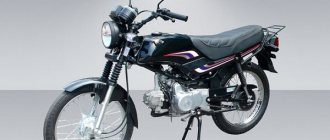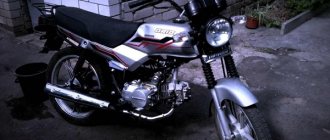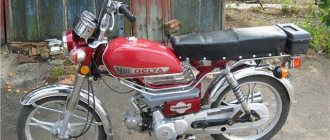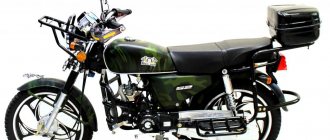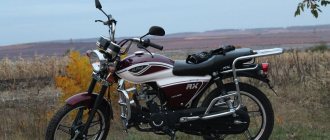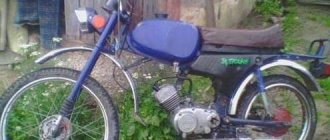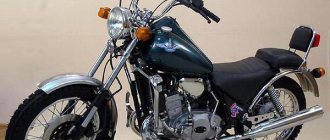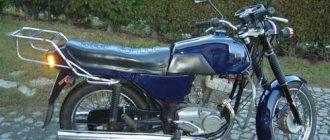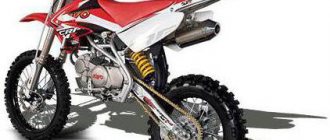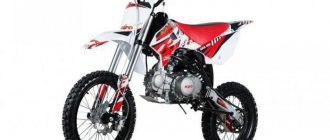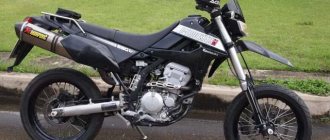Have you ever wondered what would happen if you crossed a moped with a motorcycle? And it will turn out to be a half-moped/half-motorcycle... Meet the Orion 100. The developers classified the Orion as a motorcycle , but the model itself clearly contradicts this with its entire appearance. One would like to say that this is a moped, not a motorcycle. Honda's achievement is that the Cab engine, which is also used in the Orion 100, does not outwardly reveal its cubic capacity, which can be quite different (from 50 to 125 cubic centimeters). Perhaps only a meticulous traffic police inspector will be able to notice that this is not a moped at all (and then only after seeing the demarcated speedometer scale up to 120 km/h).
001_MOTO_1010_032
Stels Orion 100, road, 2010, 97 cm3, 7 hp, 84 kg, 30,000 rub.
Stels Orion 100, road, 2010, 97 cm3, 7 hp, 84 kg, 30,000 rub.
For two years now, while testing equipment in the outback, I noticed: men who don’t look like bikers have switched to unprepossessing-looking Chinese vehicles, which have replaced the dying “Rigs”, “Karpatys” and “Minskis”. This technique is not used for fun, but purely utilitarianly - to transport a bag of root vegetables or to get to a fishing spot to pick up mushrooms and berries. Frankly speaking, I looked with disdain at such equipment, leisurely parading along towns and rural roads, without feeling the slightest desire to change it. But he called himself a milk mushroom - get into the back! The market suggests that it’s time to test new products in this segment.
Judging by the index, the Orion 100 is a full-fledged motorcycle, although you can’t tell from its appearance. This is how the simpler and more familiar thing rolls around on the tongue - a moped. As you know, the “Cab” engine (this, without exaggeration, Honda’s greatest invention is described in detail in “Moto” No. 1–2010) outwardly does not betray its cubic capacity, which can vary from 50 to 125 cm3. A meticulous traffic police inspector may suspect that this is not a moped, except by looking at the speedometer scale, marked up to 120 km/h. However, the dealer of this equipment is not lying: he issues a title, and what follows is up to the owner’s conscience. Looking ahead, I state: having driven 1,100 km in the city and highway in a week, I never caught the inspector’s eye on me.
But a moped is not simple! The luxurious two-tone seat made of non-slip material (570 mm long) will be the envy of other motorcycles. But the main thing is that the suspension is strengthened: the rear shock absorbers of impressive size have hydraulics, spring preload adjustment (5 positions), and the spring itself has a variable coiling pitch. They are good - they don’t penetrate, but they dampen. You really want to hit a pothole in the asphalt to feel how they work. But the hydraulics of the fork, compared to the rear suspensions, are “four”, but still work. Given the rather large wheels (17 inches), the car is perfectly suited for bad roads.
The steering wheel is moderately high and wide (650 mm), the landing is straight and not tiring. And the trip to Seliger and back (900 km) confirmed this. After scooters and scooterettes, the “manual” clutch was somewhat alarming - what would it be like in the city? But it turned out to be normal, the gear shift was surprisingly clear and with little effort. And the neutral was “caught” perfectly. I was pleased with the “normal” order of gear engagement, otherwise many Chinese “Cab” clones use a reverse or circular order, which is confusing. The remote controls on the steering wheel are familiar, although simple in appearance. There is no “engine stop” button, which, by the way, is mandatory on motorcycles - another bias for a moped. The tidy was both pleasing and disappointing. I was pleased with the tachometer and the large, easy-to-read speedometer dial. And I was upset by the fact that in daylight you can’t see whether the control lights are on and, most importantly, the gear indicator. And the fuel gauge is also really missing, but that’s a separate discussion.
It’s gratifying that one key opens three different locks: the ignition, the anti-theft lock under the lower crossmember (there is no central locking here) and the tank lid. To start the engine, you need to open the gas tap and turn on the enricher - these operations are unusual for scooters, but commonplace for motorcycle owners. The tap is not difficult to find, but the position of the flag is disconcerting: the horizontal position here does not mean “closed”, but “reserve”. By the way, as subsequent trips showed, he was not there. Finding the enrichment lever turned out to be more difficult - I had to get off and look at the carburetor. And even then it was not always possible to find it by touch; it was a waste of time to save on the cable.
It was not possible to use the electric starter right away - the battery ran out. With the kick, the engine started up willingly, but the kick itself turned out to be of such an awkward shape that it left no room for the foot on the footrest (on the other hand, the foot was hampered by the uncomfortable brake pedal). You have to seriously clubfoot, twisting your leg. I quickly got tired of it, and when the battery was recharged, I removed the kick altogether. In general, the poor ergonomics of the right leg area is the most serious drawback of the motorcycle. And not only this, but also other mopeds and scooters with “Kab” engines from other manufacturers. In addition, the brake pedal is very low above the ground, and when braking it catches on the slightest bumps.
After warming up the engine, I drove into the hell of the capital's traffic jams. Surprisingly, getting between cars is sometimes even more convenient than on a scooter - the Orion weighs only 84 kg, the steering wheel is not too wide, and the wheels are large. There was no need to shift frequently, thanks to the elastic characteristics of the engine and long gears. The gear ratios of the box are perfectly chosen. With the first, the device even starts to “go crazy”, the second and third are close, and the second is perfect for country driving in bad conditions - the engine pulls at the bottom. The miracle begins with fourth - turning it on from 30 km/h (2500 on the tachometer), the engine turns and turns, and the tachometer reaches the red zone (8500 rpm) at 90 km/h. The most pleasant speed range is 65–70 km/h: minimum vibrations and noise from the muffler. Fourth gear can be engaged at 25 km/h (2000 rpm) - the engine is amazingly elastic. But even in the city, in the gaps between waves of traffic jams, when crazy car owners accelerated, the device also kept up with the general flow.
The brakes, even though they are drum brakes, work “at five” from new: it seems that you can do a stoppie and let the rear wheel skid on the asphalt. Perhaps the only incident was that when the “flashing lights” were turned on, their sound repeater worked so loudly and obnoxiously that everyone turned around. However, soon the problem “resolved” on its own - something died in the electrics, and I had to “semaphore” with my hands according to the old habit. But the process went further - the flashing light fell off (the plastic ear cracked). An autopsy showed that the turn signals were apparently made in school workshops: instead of a terminal, there was a wire end twisted into a ring and filled with tin. Soon, when the ignition was turned on, the sound signal began to make sounds as if it was talking to itself - I had to pull the terminal off it (which turned out to be surprisingly easy). In general, driving around the city became uncomfortable, and I breathed a sigh of relief when I went on a long drive.
The path lay ahead to Seliger. After 114 km, the highway ended and a dangerous section began to Zubtsov, with broken asphalt in the longitudinal ruts. The road is narrow, with dirt shoulders. To quickly cover these 60 km, I kept full throttle - the device went 85 km/h, and downhill and with the wind - all 90. By the way, the standard speedometer overestimated the readings by 10 km/h (I measured it using a GPS navigator). It turned out that you can accurately determine the speed using the tachometer, for example, the number 7 (that is, 7000 rpm) exactly corresponded to a speed of 70 km/h. Thus, the maximum speed before entering the red zone corresponded exactly to 85 km/h. Along the way, I noted that the suspension worked well, and the rigidity of the frame was acceptable (the total weight of me and the luggage was about 120 kg). A three-liter tank on the highway in this mode was enough for exactly 100 km. At the same time, gasoline did not flow from the reserve compartment, it’s good that “I had it with me.” Gas station with such a small tank, especially when it is unclear how much gasoline is in there (the neck is very narrow, you can’t see) is a real pain. Life was made somewhat easier by a two-liter plastic bottle with a “reserve”, which received a permanent registration on the trunk, which, by the way, was very conveniently located between the legs.
So, having quietly traveled 450 km in 8 hours, I ended up on the shores of Lake Seliger. But the tests are not over yet! Ahead is a seasoned off-road on muddy roads. I prepared for it - I stocked up on Heidenau tires size 2.75-17 with K58 winter tread. Naturally, he decided to put it on the rear wheel, and the original rear one on the front, where its tread seemed more suitable for off-road use than the original one with longitudinal grooves.
Tire work also provided useful information. Firstly, in order to remove the standard set of tools from under the saddle, you need to unobtrusively carry a “10” wrench in your pocket. And secondly, using this set you can’t remove the wheels - you need a “17” wrench, and for dismantling you also need mounting brackets. Along the way, I also appreciated Chinese tires - very elastic, but anonymous (“just tires”). I removed the wheels without any problems, but about the muffler mountings (I wouldn’t be surprised if they fell off soon) and the design of the rear brake reaction rod with cotter pins. The K-58 tread is simply magnificent! I heard flattering reviews, but I didn’t think that the tire would be so grippy. The low weight of the device, the high-torque power of the engine and the properties of the rubber made it possible to drive where the natives use motor vehicles on cross-country tires after rain. Of course, you can’t go as fast as a cross-country racer on such tires, but do villagers and fishermen need to drive? But you can always drive confidently with minimal physical effort on such tires.
The return trip didn’t add any new impressions, except that I appreciated the waterproofness of the ignition circuits—halfway through the trip I was driving in the rain. But upon arrival I discovered a cosmetic defect - the muffler had “bloomed”, and this was after a run of 1100 km!
Security measures
The designers of the Stealth brand approached the safety of the moped with full responsibility. The fuel tank cap, steering wheel lock and engine start can be unlocked with one key. Typically, in order to get moving, you first need to open the gas tap and turn the enrichment device to the on position. I was very surprised by the “new thing”, unconventional for a gas tank flag, its horizontal position means “reserve”. While, as usual, everyone is accustomed to thinking that after Soviet motorcycles and mopeds the position is “closed”.
011_MOTO_1010_032
RESULT. As a motorcycle, the Orion 100 is the lightest, cheapest and simplest vehicle, and also easy to ride (if ridden alone).
The design of “cab” motors, proven over half a century, allows us to hope for a significant service life and availability of spare parts. But the light and sound “body kit” is not reliable enough, but this is of decisive importance in city conditions, and besides, correcting the shortcomings is not very difficult. The chassis and transmission reveal their advantages most of all on rural roads and light off-road conditions. With moped looks, the Orion 100 doesn't attract attention on the road. In short, it’s a decent utilitarian motorcycle with no other pretensions. Technical characteristics of Stels Orion 100 (manufacturer data)
| COMMON DATA | |
| Model year | 2010 |
| Dry weight, kg | 73 |
| Length/base, mm | 1900/1230 |
| Seat height, mm | 850 |
| Ground clearance, mm | 80 |
| Gas tank volume, l | 3,5 |
| Load capacity, kg | 138 |
| Maximum speed (measured), km/h | 85 |
| ENGINE | |
| Type | 1-cyl., 4T |
| timing belt | ONS-2 |
| Working volume, cm³ | 97,2 |
| Cylinder diameter × piston stroke, mm | 50×49,5 |
| Compression ratio | 8,8 |
| Max. power, hp at rpm | 7/8500 |
| Max. torque, Nm at rpm | n.d./7000 |
| Supply system | carburetor |
| Cooling system | air |
| Starting system | electric starter+kickstarter |
| TRANSMISSION | |
| Transmission | 4-speed |
| main gear | chain in casing |
| CHASSIS | |
| Frame | steel, spinal type |
| Front suspension | telescopic fork |
| Stroke, mm | 90 |
| Rear suspension | pendulum, with two hydraulic shock absorbers, adjustable spring preload |
| Brake system | separate, hydraulic, with ABS |
| Front brake | drum |
| Rear brake | drum |
| Front tire | 2,50–17 |
| Rear tire | 2,75–17 |
Test equipment provided.
Strong but light: Stels Orion 100 test
Expert opinions
As soon as you sit on the moped, you immediately feel a high-quality seat with a thick layer of cushion filler. Such things are always found on expensive equipment, but here on the budget Orion it is provided. The seat length is 570 mm, a comfortable ride can be carried out simultaneously for the driver and passenger. Due attention must be given to the suspension. The rear shock absorbers are based on the hydraulic principle. Their penetration is unlikely, but damping still appears. In general, sometimes you want to specifically “catch” a hole and feel the quality of the rear suspension. With the front shock absorbers, everything is not so good; they work at 3-plus. But they are complemented by large wheels, which are indispensable on poor off-road conditions.
The dashboard rationally accommodates the tachometer and speedometer in a large size. Its disadvantage is poor visibility during daylight hours. There is no fuel level indicator at all, which is a big drawback. Sometimes you lose count, that is, you forget what gear you are in. This is “helped” by the same weak diodes on the instrument panel.
The foot brake causes a lot of inconvenience. It is located very low, it often scrapes against the road surface when taking sharp turns. The braking system is quite reliable; disc brakes give no reason to think about their ineffectiveness.
The cost of this moped may vary, but on average you can buy an Orion Stealth 100 moped for 40,000 - 45,000 thousand rubles. Overall, the equipment is worth purchasing. Cost-effectiveness, high maneuverability and ease of operation really encourage a bargain purchase, especially since the price of the Orion Stealth 100 is insignificant.
What do you get if you cross a moped chassis with a “Cab” motorcycle engine?
Strong but light: Stels Orion 100 test"Orion" is a representative of the Russian brand Stels
Mopeds of the Orion family are becoming increasingly popular motor vehicles in our country. They are assembled at the enterprises of the Russian holding Velomotors under the Stels brand. “Orion” is a moped made on the basis of Chinese components, but some of its key elements were manufactured at Stels factories in Russia.
At the Zhukovsky Motorcycle Plant they make a frame and some external elements for these light motorcycles. The company strives to replace imported parts, and every year the share of Russian-made parts and mechanisms in the design of these mopeds increases.
Mopeds, photos of the assembly line of which are presented in the article, undergo the final stage of quality control.
Models with a large gas tank and case
Models with six- and eight-liter gas tanks and a trunk case are equipped with engines ranging from 50 to 120 cc. see and belong to type “B”. The Orion moped, a photo of which can be seen below, has a layout that differs from type “A”.
A very important difference between types “A” and “B” is the different position of the hands when landing. Type A models have a higher steering wheel and are easier to control. Model “B” provides a position for the motorcyclist that helps reduce drag.
The Orion 125 V moped differs from the Orion 50 V (72) only in its greater weight and 120 cc motor power. The noticeable difference in the power of the Orion engines creates very large differences in their dynamic characteristics. "Orion" 110 is a moped, which, according to the traffic rules of the Russian Federation, should be considered a motorcycle. It is the same "B" variety with a large gas tank and rear case, with a corresponding 110 cc engine. cm. The price for model “B” ranges from 21 to 27 thousand rubles.
There are luxury options in the Orion family. "Orion" Lux is equipped with an alarm system and a more powerful 120 cc engine. see. Structurally, this option belongs to type “B”. Price – from 31 thousand rubles. The second luxury option, the Orion City moped, has approximately the same price. This model has beautiful sporty plastic contours, a muffler with a sloping rear part, a powerful engine and an alarm system. This model also belongs to type "B". The cheapest option from subgroup “B” is the Orion 50 moped.
Differences from Chinese counterparts
Both types of Orions (types “A” and “B”) are very similar to their Chinese counterparts - mopeds of the “Delta” and “Alpha” types. The chassis, engines, both sprockets, chain, brake drums and many other important structural elements are the same. But still, the Russian assembly of the Stels brand has a number of important differences. And one of them is higher quality fasteners. Mopeds assembled in China require mandatory tightening of all elements without exception before use.
The fasteners used in Orions are more durable in material and are also stretched to a higher quality at the factory. Models of both types “A” and “B” have practically no design differences as standard from their Chinese counterparts. But the Orion 100A has a more comfortable seat, a slightly longer base and stronger wings. During driving, the front fenders on models 50 (72) A and B, made of thin stamped iron, are very often destroyed by vibration. Orions have a more durable and comfortable frame and rear wheel pendulum, which has a positive effect on the reliability of fixing the rear wheel tensioners, as well as on the convenience of replacing the air filter. One of the positive consequences of using higher-quality metal in the manufacture of the frame in Orions is the absence of destruction of the engine mounting points, while in Chinese analogues these components are susceptible to destruction when operating the version with 110 - 120 cc engines. cm.
Breakdowns that owners of Orion mopeds complain about in reviews
The most common faults are:
- Carburetor adjustment failure.
- Sprocket wear and drive chain stretch.
- Failure of the turn signal switching relay.
Serious malfunctions that may occur due to improper operation and lack of control over the operation of the moped mechanisms:
- Loss of compression due to improper valve adjustment, valve burnout.
- Timing chain rupture due to wear of its tension system.
- Clutch failure due to improper adjustment and cable stretching.
- Failure of chain tensioners, as well as deformation of tensioner fixing points due to wear of the sprockets and the chain itself.
